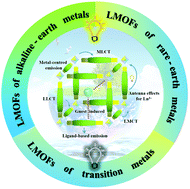Recent progresses in luminescent metal–organic frameworks (LMOFs) as sensors for the detection of anions and cations in aqueous solution
Abstract
The discharge of excessive metal ions and anions into water bodies leads to the serious pollution of water and environment, which in turn has a certain impact on industry, agriculture, and human life. Because of the unique advantages of luminescent metal–organic frameworks (LMOFs), they have been successfully explored as various fluorescent probes to quickly and effectively detect these pollutants. This perspective not only introduces the design strategy and classification of LMOFs, especially the construction methods of water-stable LMOFs, but also reports the latest progresses in some LMOFs between 2016 and 2020 as well as expounds the mechanisms of LMOFs for detecting anions and cations. Moreover, the luminescence properties of LMOFs are related to the selection of metal ions, the structure of organic ligands, the pore size, and the interaction of guest molecules. Finally, the further development of LMOFs is summarized and prospected in this field.

- This article is part of the themed collections: Dalton Transactions up-and-coming articles and 2021 Frontier and Perspective articles


 Please wait while we load your content...
Please wait while we load your content...